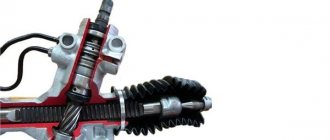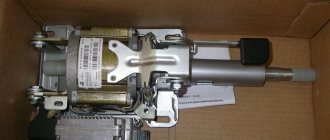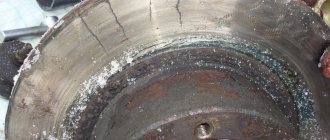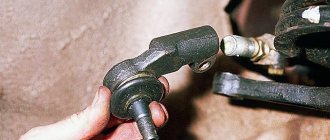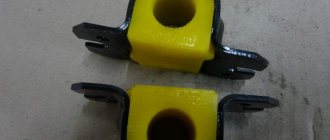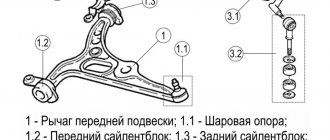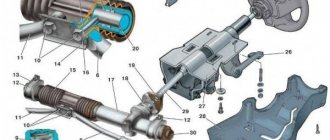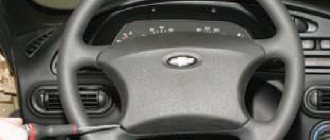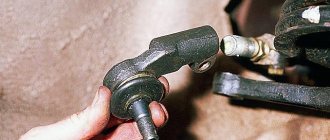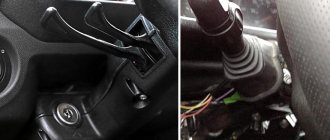Who knocked? Steering end
Of course, the goal of diagnostics is to find the faulty part and replace it. To check the condition of the tie rod end, you need to lift the car (the wheel should not touch the ground). Then it must be rocked in a special way, applying force at the “9 o’clock” or “3 o’clock” point. This swaying will allow you to feel the backlash. If it exists, you need to understand its source.
First, let's find out whether the steering tip is to blame for this. To do this, we swing the wheel in the same plane with one hand, and place the other hand behind the wheel and place it so that it touches the steering tip and the steering knuckle. If there is a gap there, you can easily feel it when rocking.
What does this have to do with the ball joint?
There is a possibility that the gap will not be detected, although the play will be obvious. And here you should suspect problems with the ball joint. You can check whether it is really faulty in the same way as in the case of diagnosing the steering tip. It is necessary to rock the wheel by placing one hand on the ball joint. If there is a gap, it will be impossible not to notice it.
If you discover malfunctions during the diagnostics described, do not delay in replacing damaged parts. This can lead to their permanent breakdown during the trip and a serious accident. After the repair, do not forget to go to a service center to have the wheel toe angles adjusted. It is necessary!
- How to remove a wheel if the edges of a bolt or nut are torn off, see (and read) here.
Please send all questions and suggestions regarding the “Technical Environment” series of issues to:
Other episodes of “Technical Environment” are available in our special project, as well as on our YouTube channel.
Knock in the steering rack: how to determine how to eliminate the knock
The design of a car includes dozens of different components. Some of them become unusable during operation, as evidenced by the appearance of specific sounds. One of these is a knock in the steering rack. In this article you will find useful information on how to determine the malfunction, what methods are available for diagnosing and repairing the breakdown.
Causes of knocking in the steering column
The steering column does not have a very complex design, however, this does not mean that the system is trouble-free and does not require attention. Regular checking, adjustment and restoration of the functionality of this mechanism will help preserve the life and health of the driver, passengers and pedestrians. The knocking noise may be accompanied by the steering wheel beating when braking. Such manifestations can appear unexpectedly and are caused by:
- deformation of system parts;
- looseness of fasteners;
- leakage of working fluid from the mechanism or lack of lubrication in it;
- loosening the ball joint nuts;
- increasing the gap between the gear and the rack;
- backlash;
- weakening the density of connections.
At the same time, there is a kickback on the steering wheel, and this is a problem that needs to be solved. A knocking sound in the column is also possible for other reasons. There are not many of them, as it seems at first glance. Sometimes it is only possible to make an accurate diagnosis when you remove and disassemble the steering wheel. Such sounds appear where the steering parts, instead of fitting tightly to each other, have lost this density.
We recommend: Diesel stalls when cold - causes of diesel engine malfunction
Often, the detection of a knock when turning the steering wheel is a consequence of misalignment of the steering rack. The malfunction can be removed by tightening it with a special wrench. There are known cases when a knock in the column comes from the electric power steering. Some defects can be conditionally determined visually and by detecting displacements at the joints of the steering column parts.
In this way, a faulty bearing is often detected. However, auto mechanics receive complete information about the causes as a result of professional diagnostics. Only she can specifically indicate where the knocking in the steering column comes from. Sometimes this is a consequence of failure or wear of the bearing located in the steering column bracket, or the needle bearing of the steering shaft crosspiece.
A few words about the steering rack
Modern rack and pinion mechanisms use two main components: the rack and the pinion. Thanks to such a simple design, the part has a long service life and is capable of properly performing its functions for more than 100 thousand kilometers. However, failure is possible, and then you will have to carry out repairs.
The operating principle of this device is also quite simple. When you turn the steering wheel, the rack begins to move in a given direction, which sets the rods in motion and also ensures that the wheels turn. It is recommended to carry out diagnostics immediately upon detecting a knock, since this component is responsible for driving the vehicle.
Sounds from the cabin
In modern cars, the steering wheel is not only needed to turn the car. It often houses controls for certain devices, from changing gears to turning on headlights or adjusting the audio system. Therefore, the driver has a natural concern when clicks appear in the steering column when turning the steering wheel. It is typical that the sound comes from inside the cabin from the area of the horn button.
In this case, there is no need to panic. First, you should check the correct installation and condition of the plastic lining of the column. The possibility of plastic deformation cannot be ruled out. A common reason for this phenomenon is a malfunction of individual elements of the steering column switch that produce such sounds. You can check the quality and fastening of the plastic, and replace the faulty switch. Often this is enough so that when you turn the steering wheel you won’t hear a click in the steering column.
Sometimes in the front part of the cabin, when you turn the steering wheel, squeaks are heard, similar to shuffling. Their source is hidden under the beep button on top of the speaker. At the same time, the signal for a problem with the airbag in the steering wheel comes on, and the cruise control buttons do not work.
We recommend: What to do if the starter turns, but the car does not start?
This means that the steering column cable under the airbag is inoperative. It supplies power to the mechanism of this airbag, the horn and some other devices of the car. It could simply be seriously damaged. Some motorists try to fix such faults on their own. This does not provide any guarantee of reliable operation of the cable. Taking into account the fact that this device affects safety, it is better to replace the steering column cable by experienced car service workers.
Causes of knocking
Despite its reliability, the rack design has several disadvantages. These include sensitivity to shock loads, difficulty in installation and a tendency to constant vibration. Under the influence of external loads, any component, of course, becomes unusable, which is why a characteristic knock appears.
The main reasons for this phenomenon include:
- The plastic bushing installed on the right or left side of the rack is severely worn. There is a strong backlash in the design, due to which drivers hear extraneous noise. This is especially noticeable when driving on a bad road.
- Poor tightening of connections in the steering mechanism design. It can be fixed quite simply (you need to tighten all the fasteners well).
- The appearance of corrosion, which destroys the metal and contributes to the formation of backlash.
- Damage to anthers. Dust, sand and dirt get into the structure, increasing wear of the part.
- Deformation of the crankcase, resulting in an incorrect angle between the screw and the teeth.
- Development of the resource of the central tooth.
A common problem is leakage in cars with power steering (power steering). The power steering design uses a special pump, which creates additional force when turning the steering wheel, making the process easier for the driver. When the seals fail, the pressure in the system drops, the working fluid leaks out, and accordingly, the steering wheel rotates with difficulty. As a result, this will lead to accelerated wear and knocking.
Prolonged downtime can cause the shaft to rust and difficulty turning the steering wheel, accompanied by knocking. If a hum also appears along with the knocking, this indicates a breakdown of the power steering pump. It does not build up the required pressure. The way out of the situation is to replace this component.
Most slats are made of soft metal that will wrinkle over time, so this part should be inspected regularly. Now you know why the steering rack is knocking, which means you can fix the problem.
Causes of knocking in the steering rack
Steering racks are quite reliable, but they are not without weaknesses. These are, first of all, susceptibility to shock, installation problems and susceptibility to vibration. External influences cause the breakdown of some part, which is manifested by a characteristic knocking sound in the steering rack.
The main causes of extraneous noise:
- Development of the service life of plastic bushings that are installed on the right or left side. As a result, the mechanism begins to work with play, which causes abnormal noise. This is most noticeable when driving over uneven roads.
- Insufficient tightening of bolt connections of the steering mechanism. To fix it, you need to tighten all the steering rack bolts.
- A corrosion process that damages metal parts and causes play.
- Leakage of anthers. Dirt and dust penetrate the mechanism, dramatically increasing its wear.
- The crankcase changes its geometric dimensions, violating the angle between the teeth and the screw.
- Critical wear of the central tooth.
We recommend
“Tie rod knocking: causes, diagnosis, replacement” More details
Leaks in power steering units are very common. The hydraulic booster contains a pump that creates additional force during turning. This greatly simplifies driving. Due to wear of the seals, the working fluid leaks out, and the necessary pressure cannot be created in the system. The driver needs to apply more force to turn the steering wheel. As a consequence of these processes - rapid wear and knocking during operation.
During long periods of inactivity, the shaft is likely to corrode, causing it to rotate heavily and with a knocking sound. If a hum is added to the knocking, it is a clear sign of a pump failure that is not able to develop the required pressure. The malfunction can only be eliminated by replacing the part.
The metal used for making slats is most often soft. Over time, it wrinkles. For this reason, it is important to periodically inspect the mechanism. Knowing the sources of steering rack knocking will make it easier to troubleshoot.
Checking the steering rack
Knocking in a car can occur for several reasons. Many motorists ask how to determine a knock in the steering rack. You can do this in the following ways:
- Visually and audibly. You may hear superficial and internal knocking. The first occurs due to a ruptured boot. In this case, the tip is not protected in any way, so it quickly fails. An internal knock indicates a more serious breakdown, which is best diagnosed at a car service center.
- Check if there are any gaps in the steering rod joints.
- Disconnect the cross rods. If the knocking noise remains, then the problem is in the steering rack.
It is recommended to put the car on a lift or pit, and then ask someone to turn the steering wheel. Being directly under the car, you are more likely to be able to determine the source of the sound.
When purchasing a used car, diagnostics can become more complicated. The damage will be difficult to determine, since the previous owner may have completely replaced the boots with new ones, leaving the underlying problem without a solution. In such situations, it is better to completely dismantle the entire structure.
Eliminating knocking noise in the steering rack
The easiest way to get rid of knocking noises in the steering rack is to tighten the adjusting screw. A simple solution will allow you to drive the car for some time without any problems.
Just don't over-tighten the screw. Otherwise, control accuracy will be impaired and steering response will deteriorate. You will have to make a lot of effort to turn the steering wheel. You will be more tired than usual when traveling.
Are there other ways to get rid of the knocking? Experts recommend dismantling the shaft. Disassembly is carried out depending on what type of steering column is installed on the car. With a mechanical rack and pinion design, you will need to unscrew the fastenings of the steering tips, then you can remove the gear.
To dismantle the power steering, you must first drain the fluid and unscrew the high pressure pipes. Repairing the system yourself is difficult - it requires certain knowledge and experience in carrying out similar work. You also need a reliable assistant. Repair work is carried out in the following order:
- Upon completion of dismantling, grind the removed shaft. This will remove traces of corrosion and wear from it.
- Restore worn elements and treat them with a thin layer of chrome.
- After restoration, polish all parts.
If the wear on the assembly is too great due to corrosion, parts will need to be replaced.
Even if you are sure that you know what the problem is, carry out diagnostics using special equipment. It is better to do this at a car service center.
Repair or complete replacement
If funds allow, then it is worth purchasing new parts, as they guarantee maximum service life. However, the cost of the gearbox is quite high. There is always a temptation to buy non-original parts. Sometimes they will not be inferior in quality to products from the official manufacturer, but there is always a chance to stumble upon a low-quality product.
An alternative option is to make high-quality repairs. To do this, a special repair kit is purchased, and then the oil seals, anthers and other components are replaced. If you have some experience in car repairs, then you can do it yourself. Otherwise, it is naturally recommended to contact a specialized auto repair shop. Repairing a power steering system is difficult, so it must be done by highly qualified craftsmen.
Repair procedure
Having purchased the necessary repair kit, you can begin dismantling. Here it is necessary to follow a certain algorithm consisting of the following steps:
- Completely dismantle the steering rack.
- Remove the tie rods.
- Clean the structure from dirt accumulated during operation.
- Replace worn parts.
- Inspect the shaft and install a new one if necessary.
Why remove the tie rods? This will greatly simplify the process of installing new boots. By pulling them onto the corresponding protrusions on the rod, you can achieve maximum tightness. Before assembling the rack, be sure to lubricate the internal oil seal.
If your car has a hydraulic booster, then you will first need to disconnect the high pressure pipes and then drain the working fluid into a prepared container. It is not recommended to remove the gearbox with hydraulic power steering yourself. The procedure involves dismantling the subframe, and it is impossible to do it alone.
The described technique will eliminate knocking in the steering rack. To complete the procedure, you will need a set of keys and screwdrivers, a garage with a pit. You can also always contact a car service center, where all the above operations will be performed by auto mechanics. But be careful, as they may jack up the cost of repairs or supply low-quality consumables.
Precautionary measures
To prevent the steering rack from becoming unusable ahead of schedule, you need to follow some tips.
First of all, it is worth remembering about careful driving: refusing to drive quickly over potholes on the road will be one of the guarantees for the long life of the car.
The condition of the steering is adversely affected by sudden gear changes and emergency braking. This is because the load from traction or brakes on the driving front wheels makes the rack more sensitive, especially when hitting potholes.
Often the steering mechanism suffers when parking carelessly. When the curb acts as a bump stop, the load on the wheel increases. A powerful push is transmitted to the steering rack, which can cause it to become unusable.
By following all these recommendations, the car owner can forget about breakdowns for a long time.
In order to understand in time that the steering rack is knocking, you should not neglect preventive inspections of the car. In addition, regular checks and timely replacement of faulty parts will increase the service life of the rack, and, consequently, the car itself.
Video about knocking in the steering rack and its repair:
What else you can read:
- Jaguar XE 2021 – The youngest of the jaguars
- HONDA CBR 600 F4i – Specifications and description
- Tesla Model S – The Result of Investments from Toyota and Mercedes
- Lexus LS 2021 – Japanese samurai in a new guise
- Testing the Audi A6 2021 with Pavel Bludenov.
- Bugatti SUV – Hold the steering wheel tighter
- INFINITY Q70 NEW (2017-2018) – Competitive individual
- “The best or nothing” – the car thief chose the first
If the steering rack is knocking, is it okay to drive?
Of course, your car will drive a certain number of kilometers with a knock, but it’s not worth taking risks and continuing to drive with it. In the worst case, the steering mechanism may simply jam. If this happens at high speed, the consequences will be dire.
Protect yourself and other road users. If knocking or humming occurs in the structure, be sure to carry out diagnostics or contact a service station. On some cars, due to the nature of the suspension, a slight knock in the rack may be quite normal. You can get detailed information about the problem for your make and model of car on thematic forums on the Internet.
Common causes of rack knocking
Any motorist can recognize a rack knock, even if he does not have special skills or extensive driving experience.
Why is the steering rack knocking? There are a number of factors that can cause this phenomenon. Most often, the following are to blame for a knocking steering rack:
- Poorly tightened nuts and bolts that serve as fasteners (in this situation, to eliminate the knocking, it will be enough to tighten all the fasteners);
- Worn or damaged plastic support sleeve on either side of the element. When driving on a road with potholes, play occurs, causing knocking;
- Rust, which had a detrimental effect on the bushing and caused play (to protect the car, you will have to replace the damaged part);
- Worn or worn out protective rubber covers. Due to the lack of a barrier, dust gets into the mechanism, which can cause damage to the sliding support and rack.

